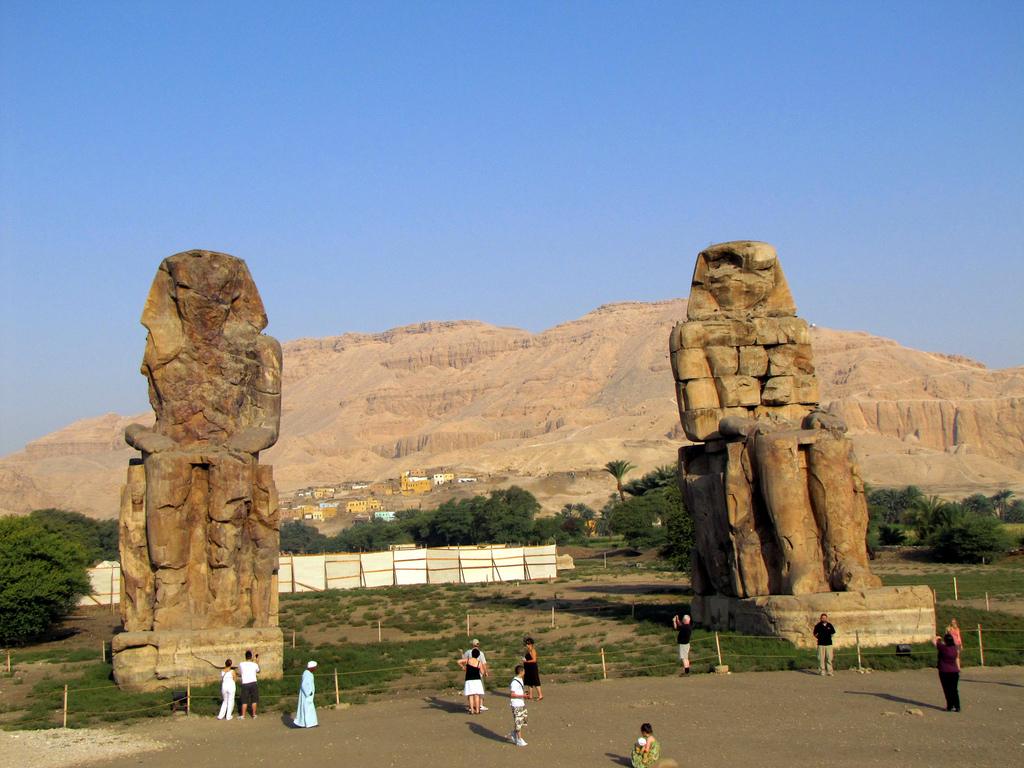Ancient Wonders of the World: Timeless Marvels Across the Globe

Throughout history, certain structures have captured the imagination of humanity and earned their place among the ancient wonders of the world. These wonders are remarkable not only for their architectural ingenuity but also for the cultural and historical significance they carry. One of the most awe-inspiring of these ancient wonders is the Colossi of Memnon. These towering statues have stood the test of time, whispering stories of ancient glory and mystery to those who visit them.
The Colossi of Memnon: Guardians of the Ancient West Bank of Thebes
The Colossi of Memnon are two massive stone statues located on the west bank of the Nile River, near the modern city of Luxor in Egypt. These statues have stood for millennia, representing the grandeur and power of the ancient civilization that created them. Each statue, standing at a towering height of approximately 18 meters (59 feet), depicts the Pharaoh Amenhotep III in a seated position, his hands resting on his knees, gazing eastward towards the Nile and the rising sun.
Constructed around 1350 BCE during the 18th Dynasty of the New Kingdom, these colossal figures served as guardians for the Mortuary Temple of Amenhotep III, which once stood behind them. Though the temple has long since been reduced to ruins, the Colossi remain, their enigmatic presence drawing countless visitors year after year.
Ancient Egyptian Architecture: An Engineering Marvel
The Colossi of Memnon are a testament to the architectural prowess of ancient Egyptian builders. The statues were carved from blocks of quartzite sandstone quarried near modern-day Cairo and transported approximately 675 kilometers (420 miles) to their current location. The sheer size and weight of these statues, each weighing an estimated 720 tons, highlight the remarkable engineering skills possessed by ancient Egyptians.
In addition to their impressive size, the Colossi exhibit intricate details that reveal the artisans’ mastery. The statues were once adorned with elaborate headdresses, pleated kilts, and other royal regalia. While much of the finer details have weathered away over time, their grandeur and artistry remain evident to this day.
Ancient Egypt Legacy: The Enduring Influence of a Great Civilization
The Colossi of Memnon serve as a powerful reminder of the enduring legacy of ancient Egypt. This civilization, known for its monumental achievements in architecture, art, medicine, and governance, has left an indelible mark on human history. The influence of ancient Egypt can be seen in various aspects of modern culture, from art and literature to architecture and religious symbolism.
The colossal statues are just one of many legacies that exemplify the ingenuity and cultural richness of the ancient Egyptians. They symbolize the grandeur and enduring influence of one of history’s most remarkable civilizations, and they continue to inspire awe and wonder in those who behold them.
Ancient Egyptian Monuments: Testament to a Golden Age
The Colossi of Memnon are part of a rich tapestry of ancient Egyptian monuments that have survived the ravages of time. From the majestic pyramids of Giza to the intricate temples of Karnak and Luxor, these monuments are testaments to a golden age of architectural and cultural achievements.
Each monument has its own unique story to tell, reflecting the religious beliefs, artistic expressions, and technological advancements of its time. Together, they form a comprehensive picture of ancient Egyptian society, offering valuable insights into the lives and aspirations of one of the world’s earliest and most influential civilizations.
Ancient Egyptian Mythology: Gods, Kings, and Legends
Ancient Egyptian mythology plays a significant role in understanding the cultural context of the Colossi of Memnon. These statues are steeped in legends and myths that add to their mystique and allure. According to ancient Greek writers, the northern statue was believed to emit a musical sound at dawn, thought to be the voice of the mythological hero Memnon greeting his mother, Eos, the goddess of dawn.
This phenomenon, known as the “Vocal Memnon,” was likely the result of temperature changes causing the stone to expand and produce sound. Nonetheless, the legends surrounding the Colossi highlight the deep connection between ancient Egyptian monuments and the mythology that permeated their culture. Through these myths, the Colossi continue to captivate the imagination of those who seek to unravel their secrets.
Tourist Attractions in Luxor: A Journey Through Time
Luxor, often referred to as the “world’s greatest open-air museum,” is home to an array of ancient wonders that attract tourists from around the globe. Among these attractions, the Colossi of Memnon stand out as iconic symbols of the city’s rich heritage. Visitors to Luxor can embark on a journey through time, exploring the historical and architectural marvels that define this ancient city.
From the sprawling temples of Karnak and Luxor to the Valley of the Kings and Queens, Luxor offers an unparalleled glimpse into the world of ancient Egypt. The Colossi of Memnon serve as a fitting introduction to this journey, inviting visitors to delve into the history and legacy of one of humanity’s greatest civilizations.
Legacy of Ancient Civilizations: Lessons from the Past
The Colossi of Memnon, like many ancient monuments, offer valuable lessons from the past. They remind us of the achievements and cultural richness of ancient civilizations and inspire us to preserve and learn from our heritage. These statues stand as a testament to human creativity, resilience, and the enduring quest for knowledge and understanding.
As we gaze upon the Colossi, we are reminded of the impermanence of human endeavors and the importance of preserving our cultural heritage for future generations. The echoes of the past, embodied in these colossal figures, continue to resonate with us, urging us to reflect on our shared history and the legacies we leave behind.


